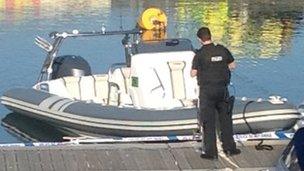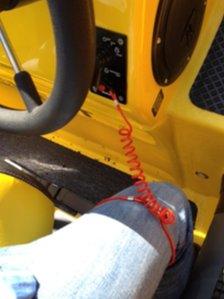Powerboat 'kill cord complacency' fears
- Published

The powerboat involved in the Padstow tragedy was capable of speeds of up to 50mph (80km/h)
Complacency about safety among powerboat users is a "real issue", according to the editor of a boating magazine.
The deaths of a father and his daughter in a powerboat accident in Cornwall has prompted police to focus their inquiry on the boat's "kill cord".
The cord is designed to be attached to the boat's throttle and the driver's leg, so if the driver goes overboard the engine cuts out.
It has not been established whether the cord played a role in the incident, but Hugo Montgomery-Swan, from Powerboat and Rib magazine, said a properly fitted "kill cord" could have averted the tragedy.
"Amateurs and professionals go out with the cord just dangling," he said.
'Cut out'
"Complacency is a real issue in boating. Accidents happen every year - it's an ongoing problem that so many people fail to attach the kill cord.
"The cord is supposed to be connected to the driver."
"If the kill cord is attached correctly the boat would just cut out," he added.
Mr Montgomery-Swan, who has 25 years' experience driving powerboats, said he believed it should be mandatory for new boat owners to complete a competency training course.
Richard Falk, the Royal Yachting Association's training manager, agreed complacency was an issue amongst "some groups of individuals, particularly people who might be rusty on boat use and might need reminding."
His organisation runs powerboat training courses and he said use of the kill cord was something it was "keen to push".
"It is absolutely something we advocate," he added.
BSkyB sales boss Nick Milligan, 51, and his eight-year-old daughter Emily were killed after being thrown from their boat in the Camel Estuary, off Padstow, on Sunday.
Mr Milligan's wife and three other children, who were also thrown into the water, were hit when the driverless boat began going round in circles.
It was only brought under control when local waterskiing instructor Charlie Toogood managed to jump on board from another craft.
The 300 horsepower Cobra rigid inflatable boat (Rib) can reach speeds of about 50mph (80km/h).
"It is a very high-powered boat, it has a quicker response time than most sports cars," Mr Montgomery-Swan said.

The "kill cord" should cut the boat's engine if the driver falls out
"The conditions [on Sunday] were beautiful and the water was calm.
"But just as a car might flip on a sharp bend, it's easy to be thrown out of a boat."
A joint police and Marine Accident Investigation Branch (MAIB) inquiry into the tragedy is ongoing.
Last September in a similar incident in the Camel estuary, the driver and passenger of a rib were thrown into the water with the empty vessel running in circles "at high speed" before eventually running out of fuel.
And in October, volunteer members of Bude inshore lifeboat boarded a runaway fishing boat to bring it under control after the skipper was thrown overboard by a wave.
The Maritime and Coastguard Agency said between 2008 and 2012 there were 19 fatalities linked to motor boats.
Mr Montgomery-Swan, who has 25 years of experience driving powerboats, said he believed it should be mandatory for new boat owners to complete a competency training course.
- Published7 May 2013
- Published6 May 2013
- Published6 May 2013
- Published5 May 2013